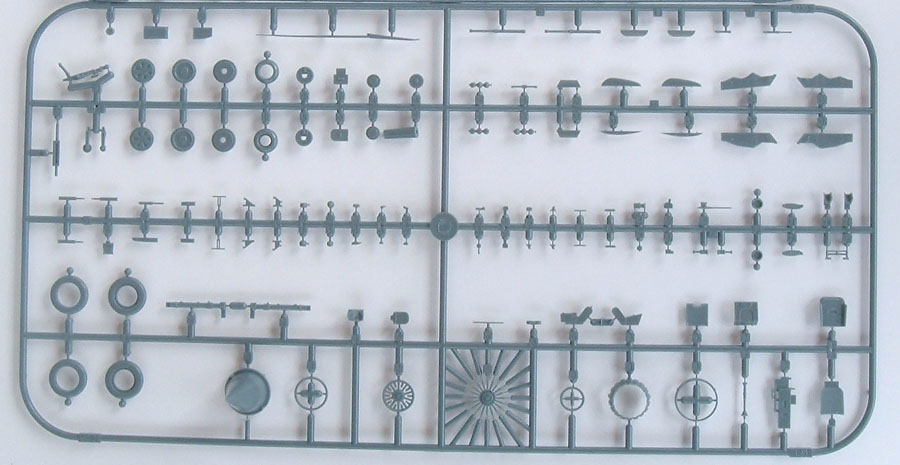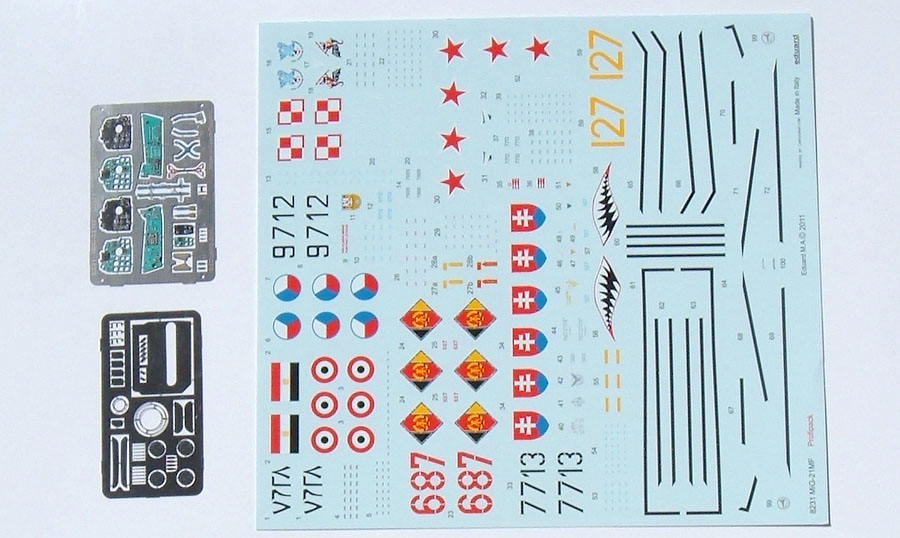Eduard 1/48 MiG-21MF
By Gerry Nilles
History
The long awaited release of what we can only hope is the first of an all-inclusive series of Eduard MiG-21s has occurred. Interestingly Eduard has chosen the final high production version, the MF, (NATO code name Fishbed J) as a starting point. The MF, which is primarily an export version, ends a span of over two decades of design and production of the MiG-21 family of fighter and trainers.
The MiG-21MF first entered service in the early 1970s. However the original design specification for this icon of Soviet airpower goes back to the early 1950s, at the time of the Korean War. Lessons learned from the use of the MiG-15 during combat in the Korean skies quickly translated into the need for a much more refined air superiority fighter. The result of this design effort of course was the MiG-21 that began initial production around 1957. The first principle production version, the MiG-21F, (NATO code name Fishbed) went into service in late 1959, early 1960. However, the "F" model entering the Soviet Air Force had a number of limitations and, for the most part, was restricted to fair weather usage, having just a basic radar system. Also because of weight considerations on performance, it only carried one cannon while having the space for the other faired over. As a side-note in 1962, the Indian Air Force ordered a small evaluation batch of the "F" model that did include both cannons regardless of said loss of performance. The next major upgrade to the MiG-21, the PF early and late series (NATO code name Fishbed D), began testing in 1961. The PF model included such improvements as initial all-weather capability, better performance that allowed two cannon configuration, and larger wheels and better brakes to name a few. Appearance wise the early production "PF" differs significantly from the "F" model in that it had a much larger intake area and nose cone, a larger spine, a wider cord vertical stabilizer, and appreciably larger fuselage blisters to accommodate the increased size of the main gear wheels. The late production "PF" included another increase to the size of the vertical stabilizer and the addition of a bullet shaped fairing at the base of the vertical for the parabrake system. Other changes include an enlarged ventral fin and a nozzle after-burned redesign.As noted above the "MF" was the last major production version of the MiG-21. The "MF" included a number of additional technological improvements over the "PF" series not the least of which was a more powerful engine. However, appearance wise the "MF" only differs from the production "PF" in that it has an enlarged, constant cross section, spine that first appeared on the PFMA model, as well as a side hinging two-piece canopy that again appeared earlier on the MiG-21PFM.
The Kit
Molded in dark gray styrene the Eduard 1/48 MiG-21MF kit is not only sharply cast, and extremely well detailed, but also without any visible flaws, sink mark etc. The kit contains no less than nine individual part trees as well as two PE frets, (one colored), "eduard mask" painting masks, and a set of two "Eduard BRASSIN" resin UB16 rocket pods. However, I should note here that two of the larger part trees are devoted exclusively to a very nice assortment of ordnance. Now, the first thing that struck me about this kit was the level of detail along with the number of small parts included. The ejection seat alone consists of 29 individual pieces (including the PE), and the detailed cockpit it goes into is nothing short of outstanding. Likewise the same can be said about the landing gear and gear bays. This is definitely a kit for a more experienced model builder. Not surprisingly, 11 of the beautifully illustrated, easy to follow, 8 ½ x 11 full color 20-page instruction booklet are devoted to the assembly process. As a side note and considering the aforementioned level of detail and number of parts, I definitely recommend that prior to starting construction a thorough review of each step be taken. Accuracy-wise, all reference this reviewer checked indicated that Eduard has done their homework very well. I might add that a consult with several fellow model builders, who also had access to the kit and whose opinions and expertise I highly respect, came to the same conclusion regarding accuracy. The only nit was that small tabs (approx 12" x 2") located on the wings just forward of the ailerons, for the purpose of airflow disruption over the control surface, were missing. These are simple to add from plastic card, though.Markings & Painting Guide
WOW!!! Without a doubt, the markings and painting guides are some of the best I have ever seen. They include six unique and completely different schemes. The first is for a tan and medium green desert colored Egyptian Air Force MiG-21MF circa 1988. Second is a dark green, dark tan and red brown Czechoslovakian Army MF that operated from 1989-1993. The third scheme is striking Slovak Air Force MiG-21MF as it appeared in 1999, done in white, medium gray and olive green. Next is a two tone gray Polish Air Force MF circa 2001-2003. Following that is a Soviet Union MiG-21SM from the Kharkov Higher Military Academy circa 1991 done in medium tan and olive green. Last is German Democratic Republic MF circa 1990 done carrying a dark tan and olive drab color scheme. Each of these fully illustrated four view (top, bottom, left and right side) color scheme guides fills an individual page in the instruction booklet along with an interesting bit of history about the individual aircraft depicted.The other marking guides, consisting of three complete color pages, are dedicated to common aircraft stenciling, weapons stenciling and coloring and pylon and weapons railing coloring and stenciling.
Conclusion
This is a highly detailed, beautifully done, kit of a subject that is indeed and icon when it comes to a modern era air superiority fighters. Add to that a half dozen outstanding color schemes to choose from along with an excellent selection of weapons, and the only conclusion is that this is a winner. This is a "must have kit" if you are into 1/48 modern military aircraft. My thanks to Eduard for the review sample.


